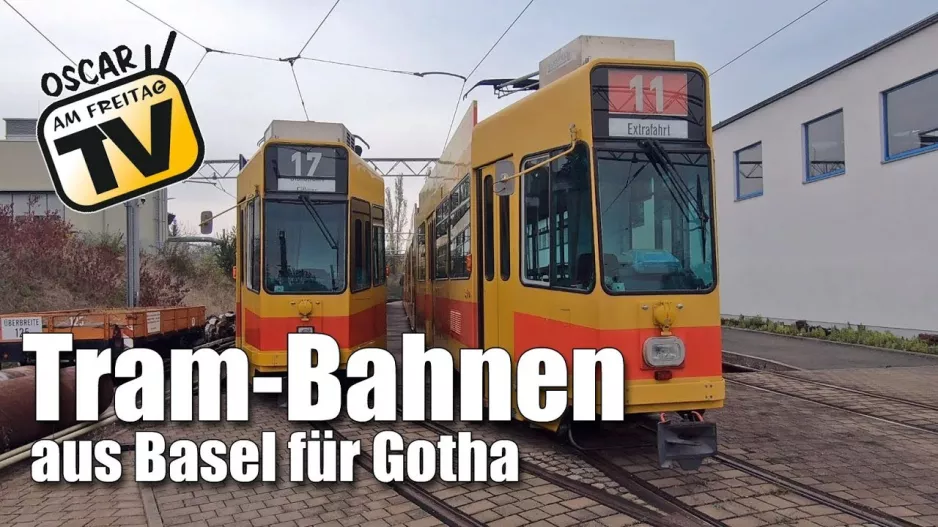Trams from Basel for Gotha
YouTube name: Oscar am Freitag-TV.
Language: German.
Date: October 28, 2018.
City: Gotha (Germany).
The video shows
Thüringerwaldbahn und Straßenbahn Gotha
Operational
Gotha regional line 4 Thüringerwaldbahn: Hauptbahnhof - Tabarz
Operational
Signed Gotha Hbf.
Description
Thüringerwald- und Straßenbahn Gotha GmbH has bought six trams. They are not brand new, have just under 1 million km on the clock. They come from Basel (Switzerland) and have, however, already undergone a number of modernizations in their 40-year life.
There is a good reason why the youngtimers, of which another 30 continue to transport Basel residents safely and well, are coming to Gotha: by 2022, all buses and trams in this country must be barrier-free - i.e., accessible to wheelchair, walker and stroller drivers at ground level. In technical jargon, this means that these buses and trams are low-floor vehicles.
Such a hip new tram costs from around 3 million euros. Money that the people of Gotha cannot afford, especially since they need more than just one of the low-floor vehicles. So they were looking for good used ones. But here too, both in Germany and in other EU countries - nothing. A member of the Gothaer Straßenbahnfreunde e. V. association found what he was looking for while on holiday in Basel. And so an exciting story began.
The next rejuvenation of the Basel railways is actually more of a reconstruction. As is well known, Switzerland is not part of the EU. Different rules apply there for the approval of a tram. The Swiss do not differentiate between streetcars and railways - everything there is called a railroad. This means, among other things, that there are uniform approval criteria. If the Thuringian Forest Railway had found what it was looking for within the EU, it might have meant less stress in terms of approval. However, the reconstruction would have been quite a lot, as operations manager Jörn Schirrmeister, who has been there for 40 years, explained.
Basel tram drivers, for example, do not have to collect the fare: there are ticket machines at every stop and you can also buy your ticket using your cell phone. Gotha has not yet got that far. That is why validators have to be installed in the trams. The displays for the route and destination also need to be revised or completely reinstalled. The seats with artificial leather covers remain. This is not a nostalgic reference to the past, but rather a very pragmatic idea: artificial leather is simply easier to clean.
The people of Basel seem to have taken bicycles on the tram quite often. In the lowered middle section, into which a very narrow staircase leads to the right and left, there are still plenty of hooks on which the bikes were hung by the front wheel. Before the interested public ponders whether and how practical this is - the forest railway workers have put a hook on the hooks. Jörn Schirrmeister justifies this by saying that the barrier-free access was the main reason for the purchase.
The Basel imports offer 66 seats and 147 standing places. They are an impressive 26 m long - like the four trams that came from Mannheim in 2011 and mainly travel to Bad Tabarz. The fleet also includes Tatra trams, although they are shorter.
The first two of the six Basel trams are scheduled to make their maiden voyage on September 21, 2019. There will be two reasons to celebrate on that day: Firstly, the 90th birthday of the Thuringian Forest Railway will be celebrated. Construction of the line to Tabarz began in 1914, but was interrupted the following year due to the First World War and its consequences. It took 13 years for construction work to resume. Since July 17, 1929, however, the Thuringian Forest Railway, affectionately known as the "jungle rumple", has been running on the 22.5 km. It is the only interurban tram in the Free State.
The second reason to celebrate is mainly for the twelve men in the workshop. Because the Basel trams will then finally become Gotha trams, which will also be painted in the traditional blue and yellow, for example.
The six, which did not travel all over the world but at least made it to the residential town, will later run on all lines, serving all 35 stops on the 38 km route network.
